Spiral into control with recurring task lists that work

“A job is a system that turns time into money. A business is a system that turns systems into money.”
@patio11
Your business is a set of things that need to be done well over and over again that provide value to a customer. There is no such thing as no process. It is just bad ones. If things are getting done - to whatever standard of quality then there is a process. Task lists, Checklists, Job tracking software. You already have a way of doing your job. It just may not be well documented or consistently delivered.
Most people think of recurring / repetitious work like this:

an endless cycle. We should think of it like this:

Repetition is an additive spiral - not an endless circle. The process itself is a closed loop - the recurring application is a spiral. Each iteration has the chance to reflect and build on the go around before it. There is no one right way to do anything. No one right system that works for all people all the time. Everyone is subject to variation unto themselves and when compared with one another.
The point of thinking this way is to connect us back to purpose. When you understand the reason you are performing a task you become open to more ideas on how to improve a process with the outcome in mind. If we are maximizing the quality of our output (or someone is managing us to make that happen) then we should only be working on worthwhile tasks. Repetitive tasks should be the most worthwhile if they've been established for the right reasons (being an integral part of delivering great value to a customer or their experience.)
Getting the work that matters documented in a way that actually gets used means getting past the mental gatekeeper both on the way in and on the way out. So lets have a look at our adversary - our own minds.
System 1 and System 2 Thinking.
Daniel Kahneman’s Thinking Fast and Slow introduces the concepts of two parts of the brain / thinking.

We love receiving consistency.
Repetition makes reputation and reputation makes customers.
-Elizabeth Arden
A big factor in the historic success of McDonalds is their consistency. In that business, customers know exactly what they are going to get when they go to a store – no matter where that restaurant is located. This has been a major business driver since they started.
After a positive experience you want to have again your expectation is that you will get the same thing. If something is different or not how you remembered it you become disappointed and unhappy.
Our brains are built to identify and respond to patterns. Once we have a pattern of something we like and we want to have it again - a deviation from that expectation elicits negative emotions. So we love receiving consistency.. but..
We hate delivering consistency
But better die than live mechanically a life that is a repetition of repetitions.
-D. H. Lawrence
Poets. Being the one who delivers that consistency is something most people have an immediate opposition to. Add a structured task list to this and all of a sudden objections of trust and lack of faith in competence also bubble up. The thing is that it is the idea of doing the job rather than the job itself that your brain is rejecting.
No surgeon ever looks at a pre-op checklist and thinks "you know that is a silly idea to wash my hands". But she may well have the thought "how silly it is that its asking me something so obvious every time". Until the time she forgets.
This is a battle of internal wills. Your brain loves doing repetitive things that it has a stored pattern for. It isn't that we object to the idea of doing repetitive jobs. We object to the idea of reasoning aimlessly over repetitive jobs. Doing stuff we know how to do takes significantly less cognitive energy then working out how to do something new. The brain loves being lazy. Getting past the System 2 conscious gatekeeper is the problem. It will always err towards the idea that it will always take the same level of energy to perform that task (which it won't once it is a learned behavior.)
Making a recurring task list that works.
The intended outcome is to produce a consistent result.
There are two reason this may not happen
- You don't do some of the steps.
- You don't do some of the steps correctly.
Recurring Task lists or Checklists are there to help on those two fronts.
Remember that the person performing these tasks will be accumulating a natural pattern for performance in their brain. These steps are intended to trigger that memory. But this inbuilt pattern replay is a double edged sword. It can lead to step being skipped or missed for not actually following along.
So we need to remain mindful of the content we put on our lists. We don't wont to trigger people to tune out straight away if there are actually critical outcomes related to missed activities.
Every item on that list is asking the System 2 brain to engage. Thats expensive energy that doesn't want to be spent. So it should have a really good reason to do so.
Adapted from the Checklist for Checklists follows is a 3 step plan to building and evaluating your recurring task lists with this in mind.
Drafting
Does the Checklist:
- Utilize natural breaks in work flow?
- Use simple sentence structure and basic language?
- Have a title that reflects its objectives?
- Have a simple, uncluttered, and logical format?
- Are there fewer than 10 items per section?
Planning and Design
Ensure each item is:
- A critical step and in great danger of being missed?
- Not adequately checked by other mechanisms?
- Actionable with a specific response required for each item?
- Designed to be read aloud as a verbal check?
- One that can be affected by the use of a checklist?
Have you considered:
- Adding items that will improve communication among team members?
- Involving all members of the team in the checklist creation process?
Validation
Have you:
- Tested the checklist with front line users (either in a real or simulated situation)?
- Modified the checklist in response to repeated trials?
Does the checklist:
- Fit the flow of work?
- Detect errors at a time when they can still be corrected?
- Can the checklist be completed in a reasonably brief period of time?
- Have you made plans for future review and revision of the checklist?
Conclusion / TL;DR;
- You already have a system
- Recurring Tasks are like a spiral, a perpetual opportunity to improve - not an endless cycle.
- We love receiving consistent outcomes
- We are naturally adverse to performing them
- Task lists need to be optimized for System 2 thinking to defer to System 1 Action.
- Performing repetitious behaviors are what our System 1 brains are amazing at
- Repetition without purpose is what kills.
Happiness is the longing for repetition.
-Milan Kundera





